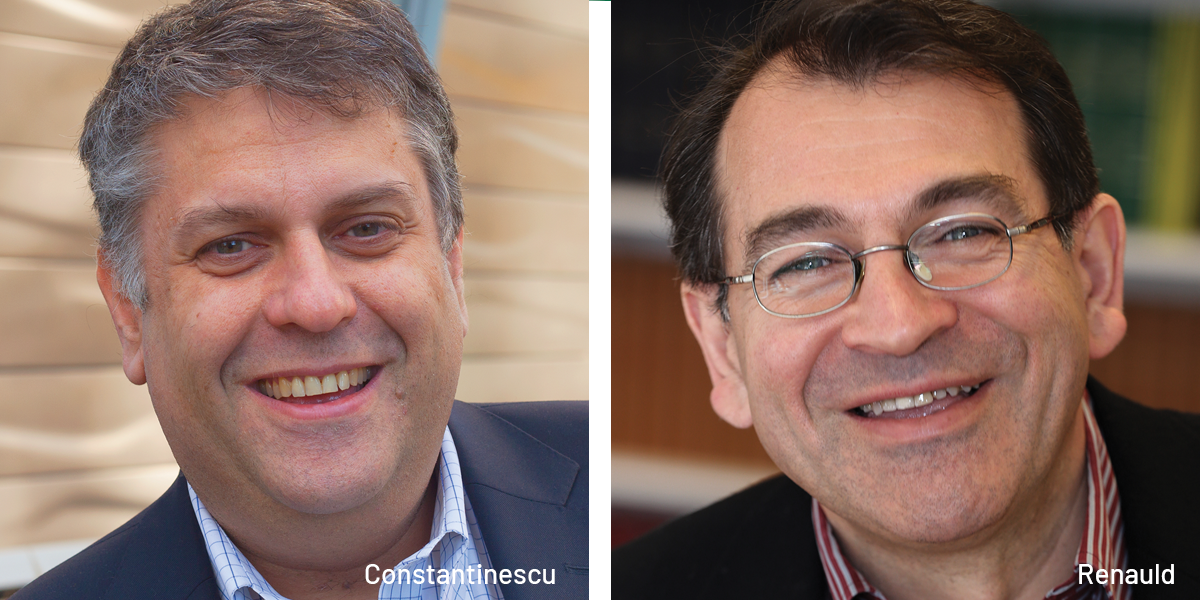Masters of the JAKs
Ludwig Brussels researchers are on a quest to expose how a family of signaling molecules influences cancer and its resistance to therapy.
Not many researchers can say that their work has contributed directly to major clinical victories. Ludwig Brussels investigator Stefan Constantinescu is one who can.
In 2005, Constantinescu and his colleagues, along with other research groups, uncovered a major molecular driver of myeloproliferative neoplasms—a group of slow-growing but potentially deadly blood cancers. Many of them, they reported, have mutations in a family of cell signaling molecules called Janus kinases (JAKs). The mutant proteins generally prompt the excess proliferation of cells that give rise to the components of blood, such as platelets, red blood cells and certain immune cells. These findings sparked a pharmaceutical race to develop drugs that target JAKs. The drugs have been approved or are being evaluated in clinical trials for the treatment of myeloproliferative disorders and some autoimmune diseases.
Constantinescu, however, stayed out of that race, turning instead to another set of problems. In 2014 and early 2015, he added to his extensive JAK signaling oeuvre with three new studies, milestones on the road to better treatments for blood cancers.
In one study, his team outlined a key driver of chronic myeloproliferative neoplasms and their occasional progression into full-blown acute leukemia. Both conditions involve a persistent activation of the protein STAT5. This regulator of gene expression is normally engaged only as required to transmit JAK signals to the nucleus. In blood cancers, however, the persistent activation of STAT5 results in the expression of an aberrant array of genes.
In many cases, the researchers found, this aberrant expression occurs in cooperation with p53, a protein that is either mutated or improperly activated in most chronic blood cancers that progress to deadly acute leukemia. “We think therapies that target STAT5 could be important for stopping progression to acute leukemia,” says Constantinescu.
His isn’t the only Ludwig Brussels lab steeped in JAK studies. On the same floor as Constantinescu’s lab, but in a neighboring tower linked by a bridge, Jean-Christophe Renauld is studying the role of wayward JAKs in a distinct but equally linked set of blood cancers known as lymphoid malignancies. These cancers, which include acute lymphoblastic leukemia, Hodgkin’s disease and peripheral T cell lymphoma, often carry mutations in the proteins JAK1 and JAK3.
Renauld and his team published a study in 2014 that is likely to have significant implications not only in his field, but also for therapeutic JAK inhibition in myeloproliferative neoplasms and for models of cancer drug resistance in general. Their studies revealed that cells treated over a long term with JAK inhibitors can acquire mutations in two different JAKs. This occurs via a sort of ping-pong mechanism, in which cells mutated in one type of JAK respond to treatment by mutating another JAK family member. Further, the two mutations cooperate in their transforming effects. This cooperation, they showed, not only significantly boosts STAT activation within cells but also confers on them resistance to JAK inhibition. The findings provide a framework for developing new treatments.
Reaching out
Renauld and Constantinescu make full use of opportunities and resources available through Ludwig’s global network. They work closely with a protein biochemistry lab at the Brussels branch and are collaborating with the Small Molecule Discovery group at Ludwig San Diego.
“The long-term support we have received has been critical to developing the experimental model we use today to conduct our studies,” says Renauld. “Access to the larger Ludwig community has been very helpful to our studies as well.”
Constantinescu, for example, recently collaborated in a study led by Ludwig Stanford’s Christopher Garcia to specifically inhibit a commonly mutated version of JAK2 using antibody-based agents called diabodies. They showed that these diabodies could from outside the cell gently manipulate the receptor to which the mutant JAK2 is attached in such a way as to turn off its aberrant signaling.
The Brussels researchers have also branched out into studies of the signaling molecule interleukin-22 with Ludwig investigator Matthias Ernst in Australia. Interleukin-22 operates through JAKs and prompts inflammation and cancer in the colon.
“These are projects that pharmaceutical firms find too risky,” says Constantinescu. “With its continuous support, Ludwig is helping us solve complicated problems.”
REFERENCES
Girardot M, Pecquet C, Chachoua I, Van Hees J, Guibert S, Ferrant A, Knoops L, Baxter EJ, Beer PA, Giraudier S, Moriggl R, Vainchenker W, Green AR, Constantinescu SN. Persistent STAT5 activation in myeloid neoplasms recruits p53 into gene regulation. Oncogene. 2015 Mar 5;34(10):1323-32. doi: 10.1038/onc.2014.60. Epub 2014 Mar 31.
Springuel L, Hornakova T, Losdyck E, Lambert F, Leroy E, Constantinescu SN, Flex E, Tartaglia M, Knoops L, Renauld JC. Cooperating JAK1 and JAK3 mutants increase resistance to JAK inhibitors. Blood. 2014 Dec 18;124(26):3924-31. doi: 10.1182/blood-2014-05-576652. Epub 2014 Oct 28.
Moraga I, Wernig G, Wilmes S, Gryshkova V, Richter CP, Hong WJ, Sinha R, Guo F, Fabionar H, Wehrman TS, Krutzik P, Demharter S, Plo I, Weissman IL, Minary P, Majeti R, Constantinescu SN, Piehler J, Garcia KC. Tuning cytokine receptor signaling by re-orienting dimer geometry with surrogate ligands. Cell. 2015 Mar 12;160(6):1196-208. doi: 10.1016/j.cell.2015.02.011. Epub 2015 Feb 26.
